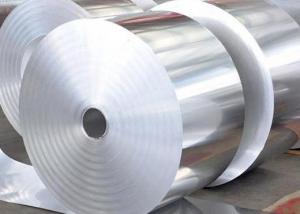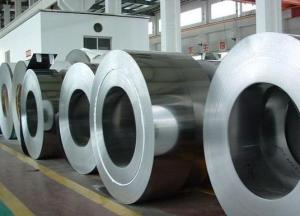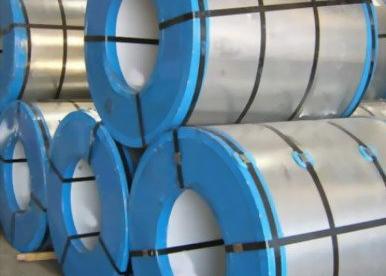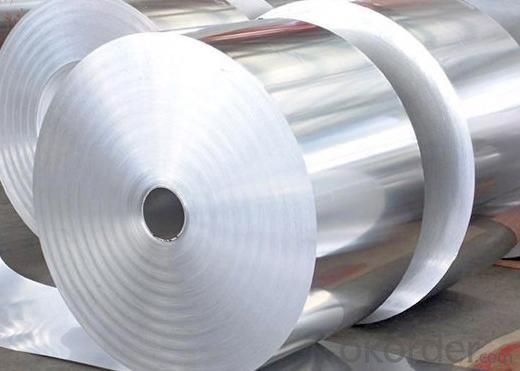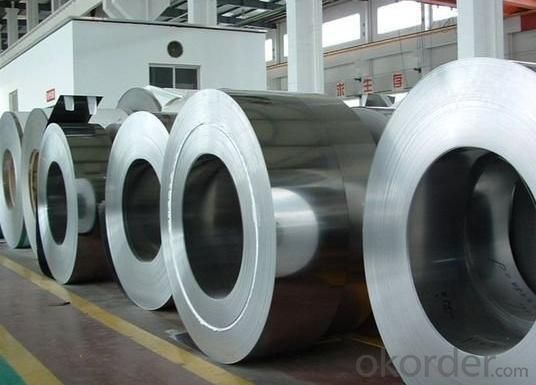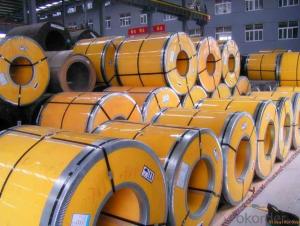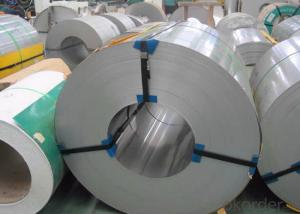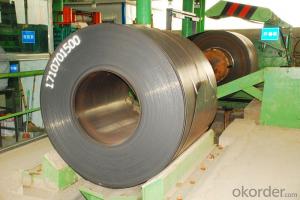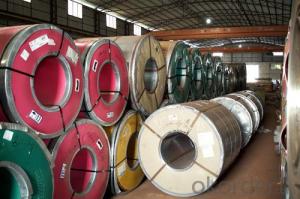316Ti Stainless Steel Coil
- Loading Port:
- China Main Port
- Payment Terms:
- TT or LC
- Min Order Qty:
- 1 Ton m.t.
- Supply Capability:
- 1000 Tons Per Month m.t./month
OKorder Service Pledge
OKorder Financial Service
You Might Also Like
316Ti Stainless Steel Coil
1. Chemical composition
|
C |
Si |
Mn |
P |
S |
Ni |
Ti |
Mo |
Cr |
|
Max0.08 |
max1.00 |
max2.00 |
max0.035 |
max0.03 |
11.00-14.00 |
5*C%-0.70 |
1.8-2.5 |
16.00-19.00 |
2. Mechanical properties
|
Yield Strength |
Tensile |
Elongation |
Hardness (HV) |
Hardness (HRB) |
|
≥205 |
≥520 |
≥40 |
≤200 |
≤90 |
3. Standard: AISI, ASTM, GB, EN, DIN, JIS
4. Surface: 2B, NO.1, BA, NO.4, Hairline, SB, Mirror finish, Anti-skid, Cherkered etc.
5. Size: Thickness: 0.3-3mm (cold rolled), 3-40mm (hot rolled)
Width: 1000mm or 1219mm or 1240mm for cold rolled, 1500mm for hot rolled.
Length: As customers' request.
6. MOQ: 1 Ton
7. Payment terms: T/T or L/C
8. Packing: Seaworthy package with wooden or Iron pallets with the paper and the steel strip, or as customers' request.
9. Delivery time: Usually about 7 days after we confirming the order, or according to your quantity.
If you have any question or demand, pls feel free to contact me.
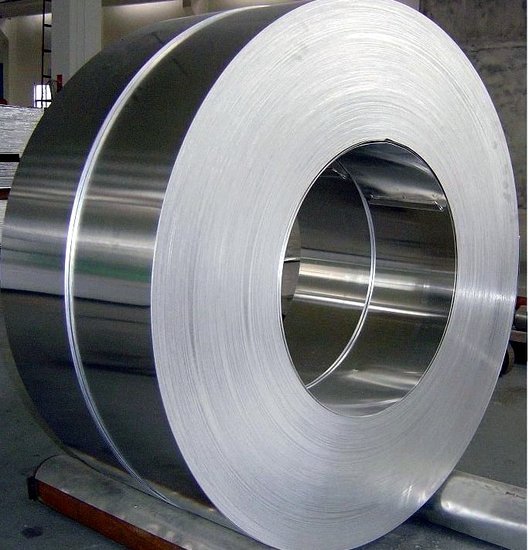
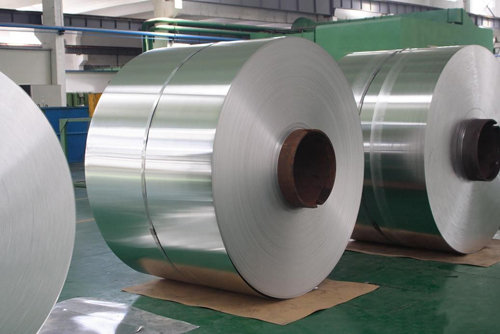
- Q: How do stainless steel strips compare to stainless steel sheets?
- Stainless steel strips and stainless steel sheets are both widely used in various industries and applications. However, they differ in terms of size, thickness, and the way they are manufactured. Stainless steel strips, also known as stainless steel coils, are thin and narrow strips of stainless steel that are typically less than 6mm in thickness. They are often used for applications that require precise dimensions, such as electrical components, automotive parts, and kitchen utensils. Stainless steel strips are usually produced through a continuous manufacturing process, where stainless steel is rolled and then coiled into a strip form. On the other hand, stainless steel sheets are larger and thicker than stainless steel strips. They come in various sizes, ranging from 0.4mm to several centimeters in thickness. Stainless steel sheets are commonly used in architectural and construction projects, as well as in the manufacturing of tanks, appliances, and industrial equipment. Unlike stainless steel strips, stainless steel sheets are typically produced through a hot rolling process, where steel is heated and then passed through rollers to achieve the desired thickness. In terms of their characteristics, stainless steel strips and sheets both offer excellent corrosion resistance, high strength, and durability. They are easy to clean, maintain, and have an attractive appearance. However, stainless steel sheets are generally more expensive than stainless steel strips due to their larger size and thickness. Overall, the choice between stainless steel strips and sheets depends on the specific requirements of the application. Stainless steel strips are ideal for projects that require precision and flexibility, while stainless steel sheets are suitable for applications that require larger dimensions and greater structural integrity.
- Q: What are the common chemical compositions of stainless steel strips?
- Typically, stainless steel strips consist of iron, chromium, and nickel. The most common chemical makeup of these strips is 18% chromium and 8% nickel, which is known as 18/8 stainless steel. This particular composition offers excellent resistance to corrosion, making stainless steel strips suitable for a range of applications including kitchen utensils, automotive parts, and construction materials. Additionally, smaller amounts of other elements like carbon, manganese, and molybdenum may be present to enhance specific properties such as strength, formability, and weldability. The chemical compositions of stainless steel strips can vary depending on the specific grade and intended use, but the presence of chromium and nickel remains consistent across most stainless steel alloys.
- Q: Can stainless steel strips be used in automotive exhaust systems?
- Yes, stainless steel strips can be used in automotive exhaust systems. Stainless steel is commonly used in exhaust systems due to its high resistance to corrosion and heat, making it a durable and reliable material for withstanding the harsh conditions of exhaust gases and moisture.
- Q: Are stainless steel strips suitable for elevator doors?
- Stainless steel strips, indeed, prove to be a fitting option for elevator doors. This durable and corrosion-resistant material finds extensive use in diverse applications, including elevator doors. Its robustness and ability to withstand wear make it a prime selection for elevator doors that experience frequent usage and constant interaction with passengers. Moreover, stainless steel possesses a sleek and contemporary look that elevates the overall aesthetics of the elevator, imparting a professional and sophisticated aura. All in all, stainless steel strips deliver the requisite durability, functionality, and visual allure demanded by elevator doors.
- Q: How do stainless steel strips resist crevice corrosion in seawater?
- The unique chemical composition and passive protective layer of stainless steel strips make them resistant to crevice corrosion in seawater. Stainless steel primarily consists of iron, chromium, and other alloying elements like nickel and molybdenum. The presence of high chromium content, typically above 10.5%, is crucial in preventing crevice corrosion. When stainless steel strips come into contact with seawater, the chromium in the alloy reacts with oxygen to create a thin, transparent oxide layer on the surface, known as the passive layer. This passive layer is highly resistant to corrosion, including crevice corrosion. It acts as a protective barrier between the metal and the corrosive environment, preventing the initiation and spread of corrosion in crevices or tight spaces. The passive layer has the ability to self-heal. If it is damaged or removed, it can quickly reform in the presence of oxygen. This characteristic ensures long-term protection against crevice corrosion in seawater, even in challenging marine environments where the metal is constantly exposed to chloride ions and other aggressive elements. Moreover, the addition of alloying elements such as nickel and molybdenum further enhances the corrosion resistance of stainless steel strips. Nickel improves the stability and durability of the passive layer, while molybdenum enhances the alloy's ability to resist pitting and crevice corrosion in chloride-rich environments like seawater. In conclusion, the resistance of stainless steel strips to crevice corrosion in seawater is due to the formation of a protective passive layer on their surface. The high chromium content, along with other alloying elements, enhances the corrosion resistance and durability of the material, making it an excellent choice for various marine applications.
- Q: What are the common applications for stainless steel strips?
- Stainless steel strips have various common applications across different industries. Some of the common uses include automotive components, construction materials, kitchen appliances, electrical enclosures, and decorative trim. They are also utilized in the manufacturing of medical instruments, equipment for food processing, and aerospace components. The corrosion resistance, durability, and aesthetic appeal of stainless steel make it a versatile material for a wide range of applications.
- Q: How are stainless steel strips made?
- The production of stainless steel strips involves a technique called cold rolling, wherein a stainless steel coil is passed through a set of rollers at room temperature. This action progressively reduces the thickness and increases the length of the coil. To begin, the stainless steel coil is unwound and cleaned to eliminate any dirt or impurities. Subsequently, it is subjected to a series of rolling mills where the thickness is gradually decreased. These mills consist of two or more rollers that apply pressure to the metal, causing it to elongate and become thinner. This process is repeated until the desired thickness is achieved. As the stainless steel strip becomes thinner, it becomes more rigid and challenging to handle. To counteract this issue, annealing is conducted at specific intervals during the rolling process. Annealing involves heating the strip to high temperatures and slowly allowing it to cool. This procedure helps alleviate internal stresses and enhance the strip's ductility. Following the cold rolling and annealing stages, the stainless steel strip may undergo additional treatments such as descaling, pickling, and passivating. Descaling eliminates any scales or oxides that may have formed on the strip's surface during rolling. Pickling involves treating the strip with an acid solution to eliminate any remaining impurities. Passivation is the final step, in which a thin, protective oxide layer is formed on the surface of the stainless steel, enhancing its corrosion resistance. Once all of these processes are completed, the stainless steel strip is cut to the desired length and packaged for shipment or further processing. Its exceptional strength, durability, and resistance to corrosion make it suitable for a wide range of applications, including automotive components, kitchen appliances, construction materials, and electronic devices.
- Q: Are 111 stainless steel strips resistant to intergranular corrosion?
- Yes, 111 stainless steel strips are resistant to intergranular corrosion. 111 stainless steel is a type of austenitic stainless steel that contains high levels of chromium and nickel, which provide excellent resistance to corrosion. The intergranular corrosion resistance of stainless steel is determined by its carbon content and the presence of stabilizing elements such as titanium or niobium. 111 stainless steel strips typically have low carbon content, which helps prevent the formation of chromium carbide precipitates along the grain boundaries, thus reducing the susceptibility to intergranular corrosion. Additionally, the high chromium and nickel content in 111 stainless steel promote the formation of a protective oxide layer on the surface, further enhancing its resistance to corrosion. Therefore, 111 stainless steel strips are generally considered to be highly resistant to intergranular corrosion.
- Q: Can stainless steel strips be used in pressure vessel manufacturing?
- Yes, stainless steel strips can be used in pressure vessel manufacturing. Stainless steel is a type of steel alloy that contains a minimum of 10.5% chromium, which provides excellent corrosion resistance and durability. These properties make stainless steel strips a suitable material for pressure vessel manufacturing, as they can withstand high-pressure environments and resist corrosion caused by various substances. Additionally, stainless steel can maintain its structural integrity even at high temperatures, making it an ideal choice for pressure vessel applications where heat resistance is required.
- Q: Are stainless steel strips suitable for appliance handles?
- Yes, stainless steel strips are highly suitable for appliance handles. Stainless steel is known for its durability, corrosion resistance, and sleek appearance, making it an ideal material for handles that are regularly used and exposed to moisture. Moreover, stainless steel can easily be cleaned and maintained, ensuring the longevity and cleanliness of the appliance handles.
1. Manufacturer Overview
| Location | Guangzhou,China |
| Year Established | 2001 |
| Annual Output Value | Above US$0.5 Million |
| Main Markets | Southeast Asia, Europe |
| Company Certifications | ISO 9001:2008; |
2. Manufacturer Certificates
| a) Certification Name | |
| Range | |
| Reference | |
| Validity Period |
3. Manufacturer Capability
| a) Trade Capacity | |
| Nearest Port | Shanghai |
| Export Percentage | 30% |
| No.of Employees in Trade Department | 10 People |
| Language Spoken: | English;Chinese |
| b) Factory Information | |
| Factory Size: | Above 30,000 square meters |
| No. of Production Lines | Above 7 |
| Contract Manufacturing | OEM Service Offered;Design Service Offered |
| Product Price Range | Average |
Send your message to us
316Ti Stainless Steel Coil
- Loading Port:
- China Main Port
- Payment Terms:
- TT or LC
- Min Order Qty:
- 1 Ton m.t.
- Supply Capability:
- 1000 Tons Per Month m.t./month
OKorder Service Pledge
OKorder Financial Service
Similar products
Hot products
Hot Searches
Related keywords
